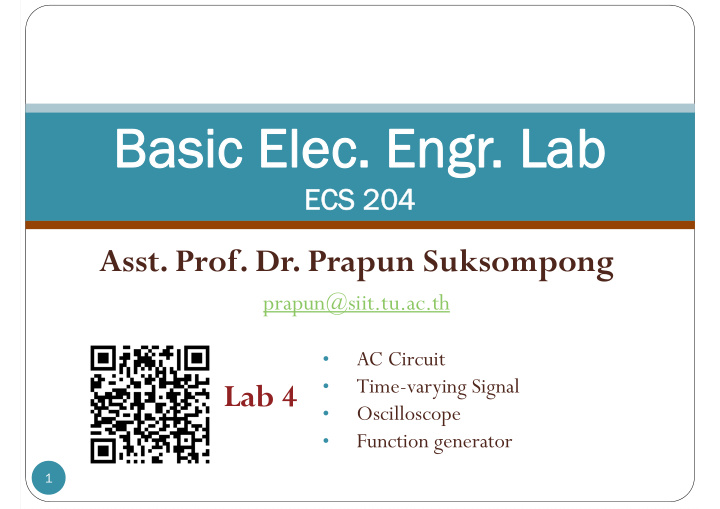



Basic Elec. Engr Basic Elec. Engr. Lab . Lab ECS 204 ECS 204 Asst. Prof. Dr. Prapun Suksompong prapun@siit.tu.ac.th AC Circuit • Time-varying Signal • Lab 4 Oscilloscope • Function generator • 1
Time-varying periodic signal (voltage) Suppose the period is T . Instantaneous value at time t: v t V Average value t T 1 0 v t v t dt V T t 0 RMS value t T 1 0 2 2 V v t v t dt rms T t 0 Peak value max T v t V p t t t 0 0 Peak-to-peak value max min V T v t v t p p t t t t t t T 0 0 0 0 2
v(t) Sinusoidal signal (voltage) t 0 T/2 T 1 2 The period is T f Instantaneous value at time t: cos v t A t V Average value t T 1 0 0 v t v t dt V T t 0 RMS value t T 1 A 0 2 2 V v t v t dt rms 2 T t 0 Peak value max T v t V A p t t t 0 0 Peak-to-peak value 2 A max min V T v t v t p p t t t t t t T 0 0 0 0 3
Steady-State AC Analysis Phasor Domain: V I Z Resistor Inductor Capacitor 1 Z Z j L Z R j C Time Domain: 4 “CIVIL”
Oscilloscope Draw a graph of a voltage over time as a trace on its screen. Cathode-ray oscilloscopes ( CROs ) Electron gun emits a beam of electrons (historically called “cathode rays”, hence the name) which is deflected according to the signal being measured. The trace is produced by the electrons striking a phosphor screen, which glows green where they hit. 5
Demo 1: Cathode-ray oscilloscope (CRO) Cathode-ray tubes: ELECTRON GUN and DEFLECTION SYSTEM. Caution : An overly bright trace can damage the phosphor of the screen if the dot is moving too slowly. 6
Oscilloscope: Display time/div Notice the grid markings on the screen. These markings create the graticule . Each vertical and horizontal line constitutes a major division . The graticule is usually laid out in an 8-by-10 division pattern. The readout for volts/div and time/div always refer to major divisions. The tick marks on the center horizontal and vertical graticule lines are called minor divisions . Dual-channel Oscilloscope: Can volts/div handle two signals at once. 7
Oscilloscope Preparation Follow III.3 and III.4. POWER (1) INTEN control (2) FOCUS control (4) CH1 (15) and CH2 (16) CH 1’s GND (19) and CH 2’s GND (20) 8
Oscilloscope Preparation Make sure that the TRIGGER MODE (26) is set to ATO mode, otherwise the trace will not be shown. Use the CH1 and CH2 POSITION controls ((9) and (10)) to align both traces on the center graticule. 9
Oscilloscope Preparation Connect the probe tips to the CAL test point (6) of the oscilloscope. VOLTS/DIV ((13) and (14)) 1V VERTICAL: COUPLING ((17) and (18)) DC ALT/CHOP/ADD (12) CHOP or ALT MODE (22) MAIN HORIZONTAL: TIME/DIV (21) 0.5ms MODE (26) ATO TRIGGER: SOURCE (29) CH1 COUPLING (28) AC The square wave of the calibrator signal will be displayed on the screen. 10
Function Generator 11
Part A 12
Demo 2 4 Vp-p Sinusoid DMM in AC Mode 13
Demo 3 (Probe) ground clips 14
Part C Oscilloscope Ch-1 Ch-2 probe tip ground clip Z1 probe tip Sine-wave generator R2 100 ohms Ground clip 15
Part C.1 Oscilloscope Ch-1 Ch-2 probe tip ground clip Z1 probe tip Sine-wave generator R2 100 ohms Ground clip 16
Part C.2 Oscilloscope Ch-1 Ch-2 probe tip ground clip Z1 probe tip Sine-wave generator R2 100 ohms Ground clip 17
Part C.3 Oscilloscope Ch-1 Ch-2 probe tip ground clip Z1 probe tip Sine-wave generator R2 100 ohms Ground clip 18
Reading Capacitor Code Code Value 0.001 F 102 0.01 F 103 0.1 F 104 0.047 F 473 0.47 F 474 4 4 1 2 4 6 6 47 10 p F 47 10 10 F 47 10 10 10 F 4 6 6 2 47 10 10 10 F 47 10 F =0.47 F 19
Demo 4: Measuring Capacitance We can use DMM to measure capacitance. Special device (LCR meter) to measure inductance. 20
Capacitor and Inductor 5 mH Inductor 0.47 F capacitor (474) 21
Recommend
More recommend